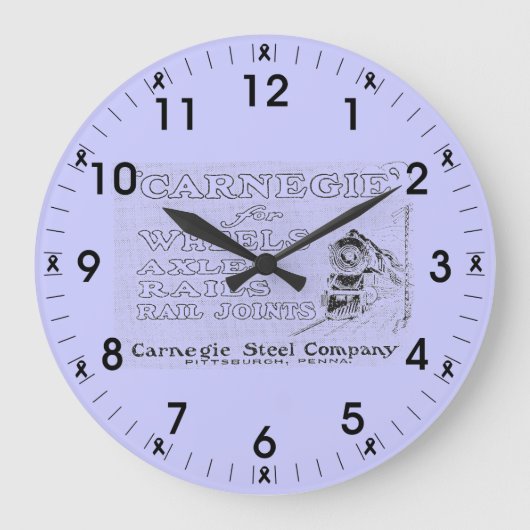
46,35 €
par horloge
Grande Horloge Ronde Carnegie Steel for Wheels,Rails and Rail Joints
Voir les détails du produitA propos de Horloges murales
Vendu (e) par
Résidents de Californie : Prop 65 Disclaimer
 AVERTISSEMENT : Ce produit peut vous exposer à des produits chimiques, y compris le plomb, qui est reconnu par l'État de Californie comme une cause de cancer et de malformations congénitales ou d'autres troubles de la reproduction. Pour plus d'informations, consultez le site www.P65Warnings.ca.gov.
AVERTISSEMENT : Ce produit peut vous exposer à des produits chimiques, y compris le plomb, qui est reconnu par l'État de Californie comme une cause de cancer et de malformations congénitales ou d'autres troubles de la reproduction. Pour plus d'informations, consultez le site www.P65Warnings.ca.gov.À propos de ce design
Grande Horloge Ronde Carnegie Steel for Wheels,Rails and Rail Joints
From www.railphotoexpress.biz
Carnegie Steel for Railroad Locomotive Wheels, Railroad Train Axles, and Railroad Joints
Andrew Carnegie was a 19th century steel tycoon who became one of the 20th century's most famous philanthropists. Hislife story is one of the most famous rags-to-riches accounts in United States history. Born in Scotland, Carnegie moved to Pennsylvania with his family in 1848 and began working in factories as a teenager. Hard work and a wise investment in a sleeping car company during the 1850s led to Carnegie's early success in the railroad business as well as the financial world. During the Civil War he invested in oil, worked in transportation for the U.S. War Department and became interested in the iron and steel business.
After the war he concentrated on steel, and by 1888 he owned control of the Homestead Steel Works and other manufacturing plants, which he eventually consolidated as the Carnegie Steel Company. With his longtime partner,Henry Clay Frick, Carnegie competed fiercely in business and tried to quash organized labor, in spite of his belief that it was the duty of the wealthy to help society (a belief he outlined in an influential 1889 essay, "The Gospel of Wealth"). In 1901 Carnegie Steel merged with the U.S. Steel Corporation and Carnegie sold out to J.P. Morgan for $480 million, making Carnegie the richest man in the world. After his retirement he became a philanthropist and donated more than $350 million to further public education, build libraries and lobby for international peace. He also created the Carnegie Corporation of New York, endowing it with $125 million to support benefactions after his death. Although he spent much of his later life on his estate in Scotland, during World War I he returned to the U.S., where he died in 1919 at Shadowbrook, his estate in the Berkshire Hills of Massachusetts.
Avis des clients
4.2 sur 5 étoiles5 Nombres de Commentaires
5 Commentaires
Avis sur des produits similaires
5 sur 5 étoiles
Par nathaie g.9 août 2020 • Achat sécurisé
Wall Clock, Ronde (Grande)
Programme d'évaluation de Zazzle
excellent produit , très beau résultat. excellente impression
5 sur 5 étoiles
Par Antoinette F.30 août 2021 • Achat sécurisé
Wall Clock, Ronde (Grande)
Programme d'évaluation de Zazzle
Je suis super contente parce que j’ai pu mersonnalisé avec mes propres photos. Je regrette juste qu’il n’y ai pas la trotteuse dans les aiguilles. Très bonne qualité et très respecté
5 sur 5 étoiles
Par Francesca S.21 septembre 2019 • Achat sécurisé
Wall Clock, Acrylique carré de 27,31 cm
Programme d'évaluation de Zazzle
C'est super mega génial je ne suis pas déçu de l'avoir recommander 😍vraiment merci beaucoup c'est magnifique 💘l'attente était mérité. Et ne plus vos services clients sont grave gentils. PARFAIT 👌 rien à reprocher
Tags
Autres infos
Identifiant du produit : 256587949306907501
Fabriqué le 29/04/2013 19:54
Évalué G
Articles vus récemment



